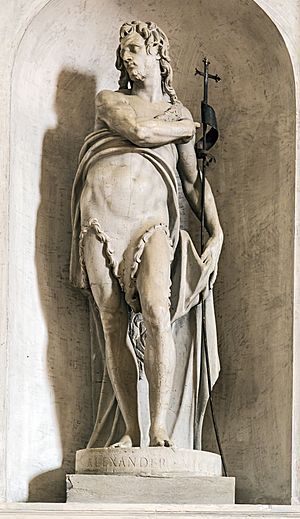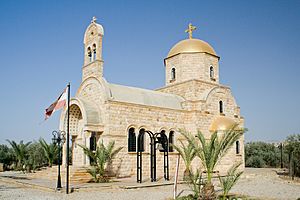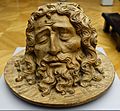John the Baptist facts for kids
Quick facts for kids John the Baptist |
|
|---|---|
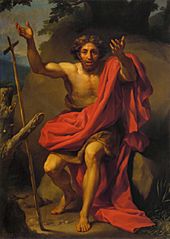
A painting of John the Baptist
|
|
| Prophet | |
| Born | Late 1st century BC Herodian Judea, the Levant |
| Died | 28 – 36 AD Machaerus, Perea, the Levant |
| Venerated in | Christianity Islam Mandaeism |
| Canonized | Pre-Congregation |
| Major shrine | |
| Feast | 24 June (Nativity), 29 August (Beheading), 7 January (Synaxis, Eastern Orthodox), 2 Thout (Coptic Orthodox Church) |
| Attributes | Red Martyr, Camel-skin robe, cross, lamb, scroll with words "Ecce Agnus Dei", platter with own head, pouring water from hands or scallop shell |
| Patronage | see #Commemoration |
John the Baptist (also called John the Baptizer or Yahya the Baptizer) is an important figure in several religions. He is seen as a prophet in Christianity, Islam, and Mandaeism. According to the New Testament, he was a preacher who baptized people.
John told people to turn to God and get ready for the coming of the messiah, Jesus. He famously baptized Jesus in the Jordan River. People would go to him to be baptized in the water. This act showed they were turning away from their past mistakes and preparing for a new life.
John was the son of Zechariah and Elizabeth, and a relative of Jesus. He was known for living in the wild. He wore clothes made from camel's hair and ate locusts and honey. In Catholicism, his birthday is celebrated on June 24.
The New Testament says John announced that someone greater than himself was coming. Christians often call John the "forerunner" of Jesus because he prepared the way for Jesus' arrival. John is also seen as following in the footsteps of the prophet Elijah.
According to the New Testament, John was put to death by Herod Antipas around AD 30. This happened after John criticized Herod for divorcing his wife and marrying Herodias, his brother's wife.
Contents
Who is Saint John the Baptist?
John the Baptist is a very important person in history and religion. He lived a simple life and preached about turning to God. He is especially known for baptizing Jesus Christ.
Where is John the Baptist Honored?
Saint John the Baptist is honored in many places around the world. He is the patron saint of Jordan. It is believed that he was beheaded in Machaerus, which is in central Jordan.
He is also the patron saint of the Commonwealth of Puerto Rico and its capital city, San Juan.
John the Baptist in Canada
John the Baptist is a patron saint of French Canada and Newfoundland. Two Canadian cities are named after him: St. John's, Newfoundland (named in 1497) and Saint John, New Brunswick (named in 1604).
In Quebec, his feast day on June 24 is celebrated as the Fête Nationale du Québec. In Newfoundland, it is known as Discovery Day.
John the Baptist in Scotland
In Scotland, John is the patron saint of Perth. This city used to be called St. John's Toun of Perth. The main church there is still the medieval Kirk of St. John the Baptist. The city's professional football club is called St Johnstone F.C..
John the Baptist in Portugal
On the night of June 23 into June 24, Saint John is celebrated as the patron saint of Porto, the second largest city in Portugal. The city's Festa de São João is known as one of Europe's liveliest street festivals.
John the Baptist in Other Places
He is also the patron of the Knights Hospitaller of Jerusalem, Malta, Florence, and Genoa, Italy. In Xewkija, Gozo, Malta, people celebrate him with a big feast on the Sunday closest to June 24.
Several places in the Philippines honor John as their town or city patron. These include Calamba City, Laguna, Calumpit, Bulacan, Balayan and Lian in Batangas, and San Juan, Metro Manila. A common tradition during his feast day in the Philippines is bathing and splashing water on people. This remembers John's act of baptism and offers a fun break from the hot weather. While Quiapo Church in Manila is famous for the Black Nazarene, it is actually dedicated to Saint John.
John the Baptist is also the patron of the Roman Catholic Diocese of Charleston. This diocese covers all of South Carolina in the United States.
The Baptistines are several religious orders named after John the Baptist.
Along with John the Evangelist, John the Baptist is also claimed as a patron saint by the Free and Accepted Masons, also known as the Freemasons.
In many Mediterranean countries, the summer solstice (the longest day of the year) is dedicated to St. John. The celebrations are similar to Midsummer festivals in other parts of the world.
How John the Baptist is Shown in Art
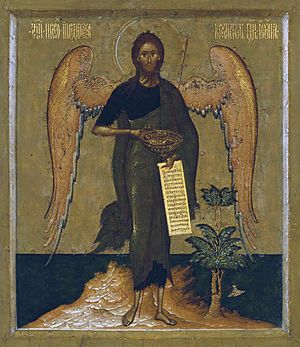
Early Christian Art
The first pictures of St. John appear in scenes of the Baptism of Christ. This was one of the earliest events from the Life of Christ to be shown in Early Christian art. By the 5th century, John was already shown as a tall, thin, and bearded figure. He and Jesus are almost always shown with long hair from early Christian times.
Byzantine and Eastern Orthodox Art
In Byzantine and later Eastern Orthodox art, John the Baptist and the Virgin Mary often stand on either side of Jesus. This arrangement, called the Deesis, is found in every Eastern Orthodox church today. Here, John and the Theotokos (Mary, the "God-bearer") stand next to a Christ Pantocrator and pray for humanity.
In Orthodox icons, John often has angel's wings. This is because Mark 1:2 describes him as a messenger.
Western Art
After the early images of the Baptism, later Western art shows St. John as a hermit. He wears camel hair clothes, carries a staff, and holds a scroll that says "Ecce Agnus Dei" (meaning "Behold the Lamb of God"). Sometimes he holds a book or a dish with a lamb on it.
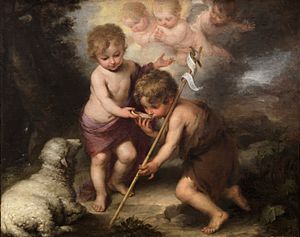
The Baptist is often shown on altarpieces for churches named after him. He is the patron saint of Florence, Italy, and appears often in the art of that city. He is also frequently seen in baptistries, which are often dedicated to him. Important artworks showing St. John the Baptist are in the Florence Baptistery. These include mosaics, bronze doors by Andrea Pisano, and a large silver altar.
Many stories from his life were shown on the predella (the base) of altarpieces. They also appeared in other settings, like the frescoes by Giotto in the Peruzzi Chapel in Santa Croce. There is also a large series of gray frescoes in the Chiostro dello Scalzo by Andrea del Sarto. The frescoed Life by Domenico Ghirlandaio in the Tornabuoni Chapel also shows his story. All these are in Florence. Another important fresco series by Filippo Lippi is in Prato Cathedral.
His birth became a popular subject in the late Middle Ages. This allowed artists to show a wealthy home interior. Famous examples include depictions by Jan van Eyck and Ghirlandaio.
As a child, John is sometimes shown from the 15th century onwards in family scenes of Christ's life. These include the Holy Family, the Presentation of Christ, and the Holy Kinship. In the Baptism of Christ, his presence was always included. Leonardo da Vinci's Virgin of the Rocks helped start a trend in the Renaissance. Many paintings of the Madonna and Child also included John. Raphael painted many such scenes, like the Alba Madonna and the Garvagh Madonna.

John was also often shown by himself as a teenager or adult. He usually wore his special clothes and carried a long, thin wooden cross. This idea was also influenced by Leonardo. Artists like Raphael, Titian, and Guido Reni developed this image. Often, he is with a lamb. This was especially true in many Early Netherlandish paintings where he wore normal clothes or a red robe over a less clear camel skin. Caravaggio painted many works showing John.
A notable Pre-Raphaelite painting is Christ in the House of His Parents by John Everett Millais. Here, John is shown as a child, wearing animal skins. He hurries into Joseph's carpenter shop with water. He joins Mary, Joseph, and Mary's mother Anne to help Jesus' injured hand.
Artistic interest in John the Baptist grew again at the end of the 19th century. Symbolist painters like Gustave Moreau and Puvis de Chavannes created new depictions. Oscar Wilde's play Salome was illustrated by Aubrey Beardsley, creating some of his most famous images.
Images for kids
-
The Preaching of St. John the Baptist by Pieter Brueghel the Elder, 1566
-
St. John the Baptist Preaching, c. 1665, by Mattia Preti
-
Matthias Grünewald, detail of the Isenheim Altarpiece
-
Shrine of John the Baptist in the Umayyad Mosque, which purportedly houses John the Baptist's head
-
A Kolkata Armenian kisses the hand of St John the Baptist at Chinsurah.
-
Tomb of Saint John the Baptist at a Coptic monastery in Lower Egypt. The bones of Saint John the Baptist were said to have been found here.
-
Serbo-Byzantine fresco from Gračanica Monastery, Kosovo, c. 1235
-
The Druze Maqam al-Nabi Yahya (John the Baptist) in As-Suwayda Governorate.
-
John setting off into the desert, Giovanni di Paolo, 1454
-
Catholic church at his traditional birthplace in Ein Kerem
-
St. John the Baptist (c. 1513–1516), Leonardo da Vinci
-
John the Baptist in the desert (1577–1621), Cristofano Allori
See also
 In Spanish: Juan el Bautista para niños
In Spanish: Juan el Bautista para niños


